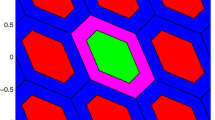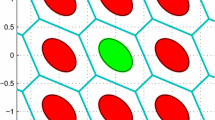Abstract
Carrier-phase integer ambiguity resolution (IAR) is the key to highly precise, fast positioning and attitude determination with Global Navigation Satellite System (GNSS). It can be seen as the process of estimating the unknown cycle ambiguities of the carrier-phase observations as integers. Once the ambiguities are fixed, carrier phase data will act as the very precise range data. Integer aperture (IA) ambiguity resolution is the combination of acceptance testing and integer ambiguity resolution, which can realize better quality control of IAR. Difference test (DT) is one of the most popular acceptance tests. This contribution will give a detailed analysis about the following properties of IA ambiguity resolution based on DT:
-
1.
The sharpest and loose upper bounds of DT are derived from the perspective of geometry. These bounds are very simple and easy to be computed, which give the range for the critical values of DT.
-
2.
The definition of DT integer aperture bootstrapping (IAB) estimator is firstly given. The relationships between DT-IAB and DT-IA are deeply investigated, which also firstly give a new perspective to review the IAB and IA least square (IALS) estimators.
-
3.
Based on the properties of the second best integer candidates in integer least square and integer bootstrapping estimators, the definition of DT-IA is given from another perspective, which is mathematically equivalent to its original definition.
-
4.
The analytical expressions of the success rate lower bound and upper bound of DT-IA estimator are firstly derived. Then, the quality measure for DT-IA estimator can be completely calculated as integer estimator without measurements. Both sharp and loose bounds of DT-IA success rate are given so that the success rates are easily evaluated, which also can provide reasonable approximation for DT-IA estimator.
All these conclusions are verified based on the single and combination GNSS simulation experiments. The experiment results indicate the correctness of these conclusions. These properties demonstrate the special properties of DT-IA estimator, and also provide the research frame to investigate other IA estimators. They are helpful to realize better use of IA estimators in quality control and precise positioning in future.











Similar content being viewed by others
References
De Jonge P, Tiberius C (1996) The LAMBDA method for integer ambiguity estimation: implementation aspects. Publications of the Delft Computing Centre, LGR-Series, p 12
Euler H, Schaffrin B (1991) On a measure for the discernibility between different ambiguity solutions in the static-kinematic GPS-mode. In: IAG Symposia NO. 107: kinematic systems in geodesy, surveying, and remote sensing, Springer, New York, pp 285–295
Feng Y, Wang J (2011) Computed success rates of various carrier phase integer estimation solutions and their comparison with statistical success rates. J Geod 85:93–103
Frei E, Beutler G (1990) Rapid static positioning based on the fast ambiguity resolution approach FARA: theory and first results. Manuscr Geod 15(6):325–356
Golub G,Loan VFC (1996) Matrix computations. The Johns Hopkins University Press, Baltimore
Han S (1997) Quality-control issues relating to instantaneous ambiguity resolution for real-time GPS kinematic positioning. J Geod 71:351–361
Hassibi A, Boyd S (1998) Integer parameter estimation in linear models with applications to GPS. Sig Process 46(11):2938–2952
Leick A (2004) GPS satellite surveying. John Wiley, New York
Li T, Wang J (2013) Theoretical upper bound and lower bound for integer aperture estimation fail-rate and practical implications. J Navigat 66:321–333
Li T, Wang J (2014) Analysis of the upper bounds for the integer ambiguity validation statistics. GPS Solut 18:85–94
Misra P, Enge P (2006) Global positioning system: signals, measurements, and performance. Ganga-Jamuna Press
Teuniseen P (2005) Integer aperture bootstrapping: a new GNSS ambiguity estimator with controllable fail-rate. J Geod 79:387–397
Teunissen P (1993) Least-squares estimation of the integer GPS ambiguities. In: Invited lecture, section IV theory and methodology, IAG general meeting, Beijing, China
Teunissen P (1999b) The probability distribution of the GPS baseline for a class of integer ambiguity estimators. J Geod Springer, 73(5):275–284
Teunissen P, Odijk D (1997) Ambiguity dilution of precision: definition, properties and application. In: Proceedings of ION GPS-1997, Kansas City, MO, pp 16–19, 891–899
Teunissen P (1995) The least-squares ambiguity decorrelation adjustment: a method for fast GPS integer ambiguity estimation. J Geod 70:65–82
Teunissen P (1998a) On the integer normal distribution of the GPS ambiguities. Artif Satell 33(2):49–64
Teunissen P (1998b) Success probability of integer GPS ambiguity rounding and bootstrapping. J Geod 72:606–612
Teunissen P (1999a) An optimality property of the integer least-squares estimator. J Geod 73:587–593
Teunissen P (2000) The success rate and precision of GPS ambiguities. J Geod 74:321–326
Teunissen P (2001) Integer estimation in the presence of biases. J Geod 75:399–407
Teunissen P (2004) Integer aperture GNSS ambiguity resolution. Artif Satell 38(3):79–88
Teunissen P (2010) Integer least-square theory for the GNSS compass. J Geod 84:433–447
Teunissen P (2013) GNSS integer ambiguity validation: overview of theory and methods. In: Proceedings of the Institute of Navigation Pacific PNT, pp 673–684
Tiberius C, De Jonge P (1995) Fast positioning using the LAMBDA method. In: Proceedings of 4th international conference differential satellite systems, Bergen, Norway, p 30
Verhagen S (2005) The GNSS integer ambiguities: estimation and validation. PhD thesis
Verhagen S, Teunissen P (2006) New global navigation satellite system ambiguity resolution method compared to existing approaches. J Guid Cont Dyn 29(4):981–991
Verhagen S, Li B, Teunissen P (2013) Ps-LAMBDA ambiguity success rate evaluation software for interferometric applications. Comput Geosci 54:361–376
Wang J (2012) Achieving high reliability for ambiguityresolutions with multiple GNSS constellations. PhD thesis, Queensland university of technology
Wang J, Feng Y, Wang C (2010) A modified inverse integer cholesky decorrelation method and the performance on ambiguity resolution. J Global Position Syst
Wang J, Stewart M, Tsakiri M (1998) A discrimination test procedure for ambiguity resolution on-the-fly. J Geod 72:644–653
Xu P (2001) Random simulation and GPS decorrelation. J Geod 75:408–423
Acknowledgments
The first author would like to thank the China Scholarship Council (CSC) for providing more than one year visiting scholarship in Delft University of Technology, The Netherlands. Part of the original research routines is provided by Dr. Sandra Verhagen in Delft University of Technology. Her support is acknowledged. Comments from Prof. Peter Teunissen greatly improved this contribution. Other anonymous reviewers are also acknowledged.
Author information
Authors and Affiliations
Corresponding author
Appendix
Appendix
Proof of Corollary 1
(DT-IAB success rate)
To deduce the success rate of DT-IAB, the success rate of IAB is given below (Teuniseen 2005)
with \(\gamma \) the scaling ratio of IAB estimator.
We will derive similar formula for DT-IAB from 1-D to \(n\)-D.
In the scalar case, the probability of DT-IAB is given as:
with \(x\) the intersecting point between 1-dimensional pull-in interval (region) and coordinate axis.
Then, its success rate of ambiguity resolution becomes
with \( \Phi (|x|)= \int _{-\infty }^{|x|} \frac{1}{\sqrt{2 \pi }} \text {exp} \left( - \frac{z^2}{2}\right) dz \). Actually, in the scalar case, the DT-IAB is the same as the scalar case of integer rounding. All IA estimators have the same properties in the scalar case when fixed failure rates are the same.
In the \(n\)-D (vectorial) case, the bootstrapping probability of correct IA estimation is given as:
with \(|x_i|\) the \(i\)th intersection point between IA pull-in region and coordinate axis.
Based on the chain rule of conditional probabilities
Hence, according to the normal distribution of float ambiguity, the success rate of DT-IAB estimator reads as:
End of proof. \(\square \)
Proof of Corollary 3
(Lower bound of DT-IA estimator)
To prove this corollary, we firstly summarize the relationship between DT-IA and ILS estimator in (51)
\(T(c)\) is the scaling ratio of \(S_{z,\text {ILS}} (c+z)\) and computed by (52).
If we apply the decorrelation step to (77), DT-IA can be approximated by DT-IAB. Then, the second best integer candidates \(c\) can be seen the same as \(c_i\),and their corresponding pull-in region
Then, the decomposition of \(\Omega _{z,\text {DTIA}}\) in (77) can be approximated by \(\Omega _{z,\text {DTIAB}} \) in (44). That is
after decorrelation.
According to the definition in Teunissen (1999a) and the linear scaling in (77), \(x\) in ILS pull-in region also has an elliptically contoured distribution \(f_z (x)\) and
The ILS pull-in regions for all members of elliptically contoured distributions are formulated as:
Since \(\Omega _{z,\text {DTIA}} \subset S_{z,\text {ILS}}\), the pull-in region of \(\Omega _{z,\text {DTIA}}\) also can be given as:
It follows that
with the indicator function
When taking the integral of Eq. (82) over \(\Omega _{z,\text {DTIA}}\), we know
Change the variable in the left side of Eq. (83) based on the replacements: \(f_u(y)\rightarrow f_u(x+u-z)= f_z(x)\), \(\Omega _{z,\text {DTIA}}\rightarrow \Omega _{2z-u, \text {DTIA}}\) and \(\Omega _{u,\text {DTIAB}} \rightarrow \Omega _{z,\text {DTIAB}}\). Thus
since after decorrelation
Hence, we have
Previously we know that
Eventually, we have
End of proof. \(\square \)
Proof of Corollary 4
(Upper bound of DT-IA estimator)
Let \(\rho = \sqrt{ c_n / \text {ADOP}^2} \) denote the radius of \(n-\)D Euclidean ball. The volume of this ball is
with
The ILS upper bound based on ADOP can be interpreted as:
When the ILS pull-in regions are scaled down to the IA pull-in regions, the radius of Euclidean ball is also scaled down to certain value. Since the scalings are different in different directions, the Euclidean ball actually is transformed into hyper-ellipsoid. To be convenient, we choose to compute the upper bound of DT-IA after decorrelation step. At that time, we can use DT-IAB to approximate DT-IA. Then, the scaling directions will be limited to those of axes. Based on the previous derivations about the scaling ratios of DT-IAB estimators, these scaled radii or axes can be given as:
This means that the Euclidean ball becomes hyper-ellipsoidal after scaling. The mean of \(\overset{\sim }{\rho }\) in all directions is denoted as:
with \( \bar{|x|}= \frac{\sum _{i=1}^n |x_i| }{n} \). There exists the following relation for the volume of Euclidian ball
The equality can be built when all scaling ratios of radius are equal. The upper bound based on ADOP of DT-IA is given as:
Then, we have
End of proof. \(\square \)
Rights and permissions
About this article
Cite this article
Zhang, J., Wu, M., Li, T. et al. Integer aperture ambiguity resolution based on difference test. J Geod 89, 667–683 (2015). https://doi.org/10.1007/s00190-015-0806-4
Received:
Accepted:
Published:
Issue Date:
DOI: https://doi.org/10.1007/s00190-015-0806-4




